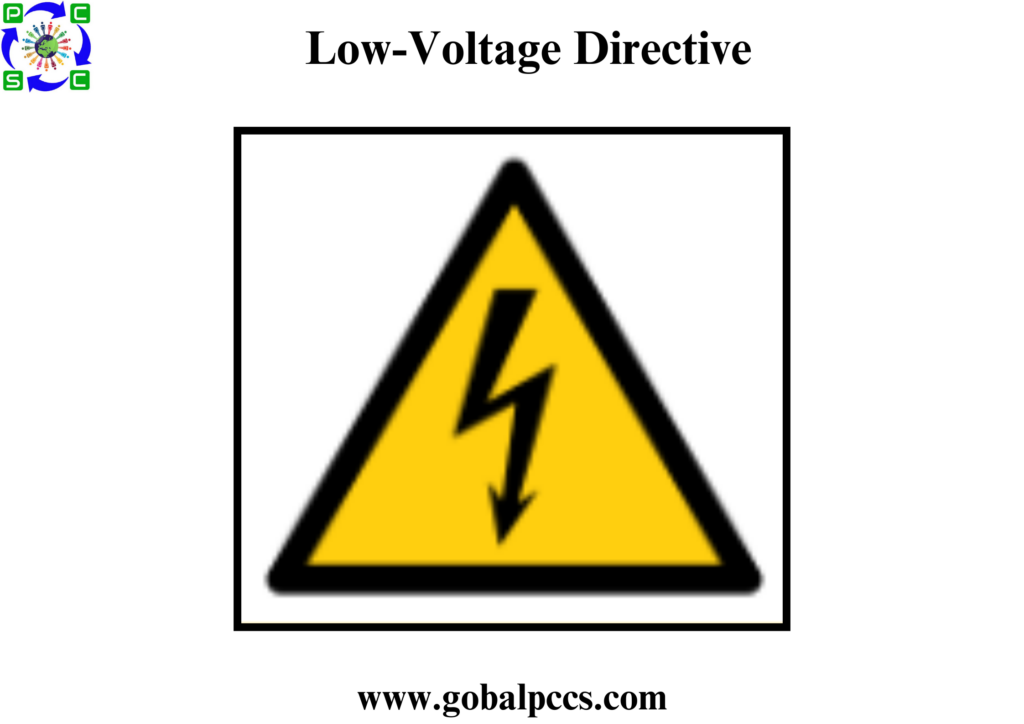 Overview:
Overview:
- The Low Voltage Directive (LVD) ensures the safety of electrical equipment designed for use with specific voltage ranges and harmonizes technical requirements across the European Union.
- Adopted on February 26, 2014, replacing the earlier Directive 2006/95/EC.
- Aims to ensure that electrical products do not endanger health, safety, or property when used as intended.
Scope:
- Operating Ranges:Covers electrical equipment designed for use with a voltage rating of 50 to 1000 volts for alternating current (AC) and 75 to 1500 volts for direct current (DC).
- Covered Products:Consumer electronics (ex: televisions,toasters), Industrial equipment(ex:Motors,transformers), Power supplies, charger and Lighting equipment.
- Excluded products:Electrical equipment for use in explosive atmospheres, Medical devices, Radio and telecommunications equipment, Electrical parts of lifts, Plugs, sockets, and electricity meters.
Objectives:
- Ensure Safety of Electrical Equipment:Protect users from risks such as electric shock, overheating, fire, and mechanical hazards.
- Harmonize Safety Standards:Create uniform safety requirements across the EU to facilitate the free movement of electrical equipment.
- Promote Market Access:Allow compliant products to be legally sold in all EU member states without additional testing or barriers.
- Protect Consumers and Operators:Ensure that electrical equipment is safe to use under normal and abnormal conditions.
Annexure Document: The LVD contains several annexes that detail its application, requirements, and conformity procedures.
- Annex I: Essential health and safety requirements.
- Annex II: List of excluded equipment.
- Annex III: Technical documentation requirements.
- Annex IV: Format of the EU Declaration of Conformity.
- Annex V: Conformity assessment procedure.
Harmonized standards: These are technical specifications developed by recognized European Standardization Organizations (ESOs) and approved by the European Commission. These standards ensure products comply with the EU Low Voltage Directive, and facilitate free trade across the EU.
- Examples of Relevant Standards: EN 60335 is applied to Household Appliances, EN 60950 is applied to IT Equipment, EN 61439 is applied to Low-voltage Switchgear.
European standard organizations(ESO’s): Below are the 3 ESO’s
- CEN( European committee for organization): It develops European standards and promotes standardization.
- CENELEC( European committee for electrotechnical standards ): Focus on electrotechnical standards and ensure safety and compatibility
- ETSI(European telecommunication standardardization institute): Focus on telecommunication standards and support innovation.
Benefits of Harmonized standards:
- Simplified Compliance: Following a harmonized standard presumes compliance with the directive’s essential safety requirements.
- Cost-Effective: It saves time and resources compared to developing proprietary compliance methods.
- Market Access:Products that conform to harmonized standards can move freely within the EU market.
- Risk Reduction: Reduces the chance of non-compliance issues during market surveillance or audits.
Restricted substances of LVD: The LVD does not explicitly list restricted substances but focuses on electrical safety requirements for products within its scope (50–1000V AC, 75–1500V DC). However, compliance with the LVD often requires adherence to related regulations that restrict specific substances in electrical and electronic products. These include:
1.RoHS Directive (2011/65/EU):The Restriction of Hazardous Substances (RoHS) applies to electrical and electronic equipment covered by the LVD. It restricts the following substances:
- Lead (Pb): < 0.1%
- Mercury (Hg): < 0.1%
- Cadmium (Cd): < 0.01%
- Hexavalent Chromium (Cr VI): < 0.1%
- Polybrominated Biphenyls (PBBs): < 0.1%
- Polybrominated Diphenyl Ethers (PBDEs): < 0.1%
- Bis(2-ethylhexyl) phthalate (DEHP): < 0.1%
- Butyl benzyl phthalate (BBP): < 0.1%
- Dibutyl phthalate (DBP): < 0.1%
- Diisobutyl phthalate (DIBP): < 0.1%
2.REACH Regulation (EC 1907/2006): Under REACH, certain Substances of Very High Concern (SVHCs) may be restricted if they are present above 0.1% by weight in any component.
Examples:
- Brominated flame retardants
- Perfluorooctanoic acid (PFOA)
- Specific phthalates
3.POP Regulation (Persistent Organic Pollutants): Prohibits or restricts the use of substances such as polychlorinated biphenyls (PCBs) and certain brominated flame retardants in electrical components.
4.Specific Material Restrictions: Insulation and conductive materials must not degrade under voltage or thermal conditions, and materials with restricted chemical properties (e.g., halogen-free requirements) may apply.
Stake holders and obligations:
- Manufacturer: Ensures that the product design and manufacturing which meets the directive’s requirements. Perform testing and maintain technical documentation for at least 10 years and also to Prepare and sign the EU Declaration of Conformity from a recognised laboratory.
- Importers: Verify that products comply with the directive before placing them on the market and ensure the technical file is available upon request by authorities that can access from the manufacturer.
- Distributors: Verify that the products affix the CE marking along with the Declaration of Conformity.
Steps to comply with LVD:
- Determine Applicability:
Confirm that your product falls within the directive’s scope (voltage range: 50–1000V AC or 75–1500V DC). Check if your product is excluded under Annex II (e.g., medical devices, equipment for explosive atmospheres).
- Design for Safety:
Ensure the product is designed and manufactured to meet the essential health and safety requirements in Annex I, including: Protection against electric shocks, overheating, and fire.Resistance to foreseeable mechanical and environmental stress.Safe operation under normal and abnormal conditions.Use harmonized European standards to simplify compliance.
- Conduct a Risk Assessment:
Identify all potential hazards related to the product.Analyze risks under normal and foreseeable abnormal conditions.Implement safety measures to eliminate or reduce risks.Document findings and risk mitigation measures.
- Test and Validate the Product:
Perform testing to verify compliance with essential safety requirements. Typical tests include:Electrical tests (e.g., dielectric strength, insulation resistance).Mechanical durability and thermal testing.Electromagnetic compatibility (if applicable, covered under EMC Directive).Testing can be done internally or by a third-party laboratory.
- Prepare Technical Documentation: As per Annex III, compile a technical file that includes:A detailed description of the product.Design and manufacturing drawings.List of harmonized standards applied.Test reports and results.Risk assessment findings.Keep this documentation for at least 10 years after the product is placed on the market.
- Draft the EU Declaration of Conformity (DoC): Prepare the EU Declaration of Conformity in accordance with Annex IV. Include details such as the product description, applicable standards, and manufacturer’s contact information. Sign the document to affirm compliance.
- Affix the CE Marking: Finally Place the CE marking on the product in a visible manner.
Ensure the CE marking and along with any additional required markings if needed (e.g., warnings or usage instruction.
Non-Compliance issues: If the product is fail to comply with the LVD below consequences have to face
- Market Access Restrictions:
Non-compliant products may be banned from sale within the EU. Customs authorities can reject shipments.
- Product Recalls:
Products already in the market may need to be recalled at the manufacturer’s expense.
Additional costs for replacement of products.
- Fines and Penalties:
Heavy fines or financial penalties imposed by EU member states.
Penalties vary by country but can include significant losses.
- Legal Action:
Manufacturers, importers, or distributors may face legal consequences, including lawsuits.
- Reputation Damage:
Loss of customer trust and brand trust.
Long-term impact on their business relationships and market competitiveness.
Conclusion:
The Low Voltage Directive focuses on regulating the safety of electrical products that operate within certain voltage limits, ensuring they are safe for consumers and reducing the risk of electrical accidents. The directive is not concerned with higher voltage transmission or industrial systems, which are regulated by other standards, but rather addresses the safety of everyday electrical devices.
Stay ahead in the world of sustainability compliance with Global PCCS, where expert insights meet the latest regulations. Unlock a future where compliance drives sustainability and your business thrives in a greener, regulated landscape.








 Authorised IMDS & CDX Training & Consulting partner for
Authorised IMDS & CDX Training & Consulting partner for






